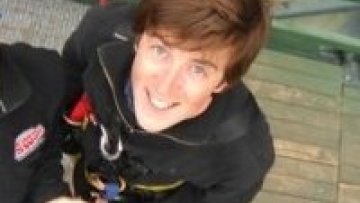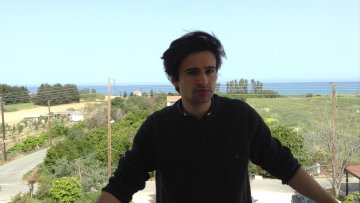Oxford Mathematician Rob Style has been awarded the 2016 Adhesion Society Young Scientist Award, sponsored by the Adhesion and Sealant Council, for his fundamental contributions to our understanding of the coupling of surfaces tension to elastic deformation.
14:15
Obstructions to positive scalar curvature via submanifolds of different codimension
Abstract
Question: Given a smooth compact manifold $M$ without boundary, does $M$
admit a Riemannian metric of positive scalar curvature?
We focus on the case of spin manifolds. The spin structure, together with a
chosen Riemannian metric, allows to construct a specific geometric
differential operator, called Dirac operator. If the metric has positive
scalar curvature, then 0 is not in the spectrum of this operator; this in
turn implies that a topological invariant, the index, vanishes.
We use a refined version, acting on sections of a bundle of modules over a
$C^*$-algebra; and then the index takes values in the K-theory of this
algebra. This index is the image under the Baum-Connes assembly map of a
topological object, the K-theoretic fundamental class.
The talk will present results of the following type:
If $M$ has a submanifold $N$ of codimension $k$ whose Dirac operator has
non-trivial index, what conditions imply that $M$ does not admit a metric of
positive scalar curvature? How is this related to the Baum-Connes assembly
map?
We will present previous results of Zeidler ($k=1$), Hanke-Pape-S. ($k=2$),
Engel and new generalizations. Moreover, we will show how these results fit
in the context of the Baum-Connes assembly maps for the manifold and the
submanifold.
14:15
Oxford Mathematician Jake Taylor King has won the Lee Segel Prize for Best Student Paper for his paper 'From birds to bacteria: Generalised velocity jump processes with resting states.' Jake worked on his research with Professor Jon Chapman. The prize is awarded annually by the Society for Mathematical Biology.
From maximal to minimal supersymmetry in string loop amplitudes
Abstract
I will summarize recent (arXiv:1603.05262) and upcoming work with Igor Buchberger and Oliver Schlotterer. We construct a map from n-point 1-loop string amplitudes in maximal supersymmetry to n-3-point 1-loop amplitudes in minimal supersymmetry. I will outline a few implications for the quantum string effective action.
A non-linear gauge transformation towards the BCJ duality
Abstract
In this talk, a concrete realization of the Bern-Carrasco-Johansson (BCJ) duality between color and kinematics in non-abelian gauge theories is presented. The method of Berends-Giele to package Feynman diagrams into currents is shown to yield classical solutions to the non-linear Yang-Mills equations. We describe a non-linear gauge transformation of these perturbiner solutions which reorganize the cubic-diagram content such that the kinematic dependence obeys the same Jacobi identities as the accompanying color factors. The resulting tree-level subdiagrams are assembled to kinematic numerators of tree-level and one-loop amplitudes which satisfy the BCJ duality.
16:00
Rediscovering Ada Lovelace's Mathematics
Abstract
Part of the series 'What do historians of mathematics do?'
Ada Lovelace (1815-1852) is famous as "the first programmer" for her prescient writings about Charles Babbage's unbuilt mechanical computer, the Analytical Engine. Biographers have focused on her tragically short life and her supposed poetic approach – one even dismissed her mathematics as "hieroglyphics". This talk will focus on how she learned the mathematics she needed to write the paper – a correspondence course she took with Augustus De Morgan – which is available in the Bodleian Library. I'll also reflect more broadly on things I’ve learned as a newcomer to the history of mathematics.
16:00
Four Colours Suffice
Abstract
Part of the series 'What do historians of mathematics do?'
"In this talk I present the history and proof of the four-colour theorem: Can every map be coloured with just four colours so that neighbouring countries are coloured differently? The proof took 124 years to find, and used 1200 hours of computer time. But what did it involve, and is it really a proof?"
16:00
Charles Hutton 'One of the Greatest Mathematicians in Europe'?
Abstract
Part of the series 'What do historians of mathematics do?'
I'm currently working on a biography of Charles Hutton (1737–1823): pit lad, FRS, and professor of Mathematics. No-one much has heard of him today, but to his contemporaries he was "one of the greatest mathematicians in Europe". I'll give an outline of his remarkable story and say something about why he's worth my time.
16:00
What is the Value of Manuscript Sources and Resources?
Abstract
Part of the series 'What do historians of mathematics do?'
" Over the last four centuries a huge amount of mathematics has been published. Most of it has, however, had little or no influence. By way of contrast, some mathematics, although unpublished in its time, has had great influence. My hope is to illustrate this with discussion of manuscript sources and resources that have survived from Thomas Harriot (c.1560--1621), Isaac Newton (1642--1727) and Évariste Galois (1811--1832)."



